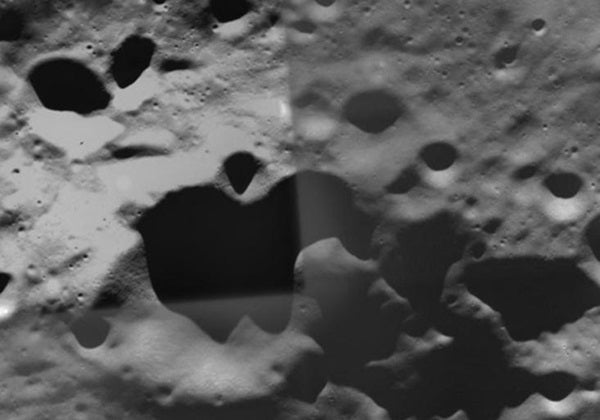The European Space Agency’s (ESA) SMART-1 team released an image of the future impact site of NASA’s Lunar Crater Observation and Sensing Satellite (LCROSS). LCROSS will search for water ice on the Moon by making two impacts into a crater named Cabeus A at the lunar South Pole. The impacts are scheduled for 7:30 a.m. EST on October 9, 2009.
Lunar Reconnaissance Orbiter (LRO): NASA’s mission to map the lunar surface
Bjoern Grieger, the liaison scientist for SMART-1’s Advanced Moon micro-Imager Experiement (AMIE) camera, and Bernard Foing, project scientist, have searched through SMART-1’s database for images of Cabeus A, taken four years ago at conditions where solar elevation and direction were similar to those of LCROSS impact. The SMART-1 image is at high resolution as the spacecraft was at its closest distance of 311 miles (500 km) from the South Pole.
Cabeus A is permanently shadowed, so ice lying inside the crater could be protected from the Sun’s harsh rays. LCROSS will send the upper stage Centaur rocket crashing into Cabeus A, and a shepherd spacecraft will fly into the plume of dust generated and measure its properties before making a second impact with the lunar surface. Astronomers will observe both impacts using ground and space-based telescopes. The SMART-1 spacecraft also concluded its mission with a controlled bouncing impact on 3 September 2006. The event was observed with ground-based telescopes, and the flash from the impact was detected at infrared wavelengths.
“We are pleased to contribute these ESA SMART-1 observations of the LCROSS target site in order to help in the planning and interpretation of impact observations,” said Bernard Foing. “This is like gathering evidence for a Crash Scene Investigation, but before the action takes place.”
“The coordination and exchange of information between lunar missions is an important step for future exploration of the Moon. Cooperation is vital if we are ever to see villages of robotic landers and eventual lunar bases, as recommended by the International Lunar Exploration Working Group,” Foing said.










